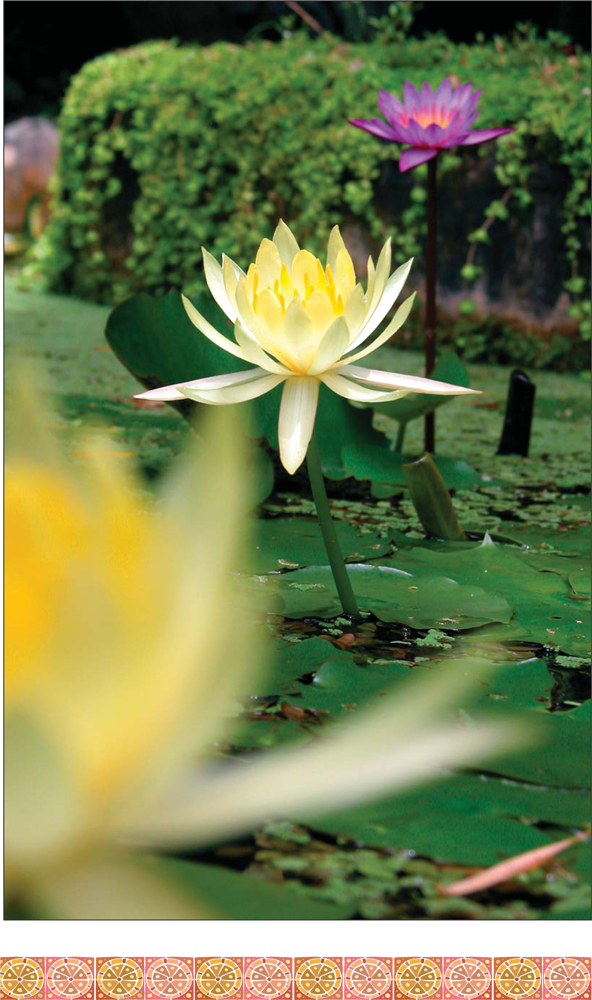
Mamsanī Ehmīmf
Shūm-Tyēīf Meditation for the Month of September
The third mamsanī begins with the portrait āūm. It is one of the most powerful portraits in the universe. All tones together make the āūm. Listen to the ocean and you hear the āūm. Listen to all the noises of a city blended together and you hear the āūm. Listen to all the tones of the physical body and you hear the āūm. When we chant the mantra Aum, and do it correctly, we pronounce the AA so that it vibrates the physical body. The OO has to vibrate through the throat area, and the MM, the head. In doing this, we are deliberately moving awareness out of the mūlādhāra and svādhishṭhāna chakras, deliberately harmonizing all the forces of the instinct and physical body, and of the īḍā and the piṅgalā currents. Chanting the AA and the OO and the MM brings the sushumṇā into power. §
This leads us to the next portrait, a fifth-dimensional portrait, āūsīsīūm, which describes the rising of the primordial cosmic energy, kuṇḍalinī. In most people, kuṇḍalinī lies coiled like a serpent at the base of the spine. Through the practice of yoga, kuṇḍalinī rises up the sushumṇā nāḍī through all seven chakras.§
The flowing line is called “nīīmf»,” awareness traveling through dimensions into the seventh dimension, and beyond into ī » kaīf». When the kuṇḍalinī rises into the realms of pure actinicity, the pineal gland and pituitary center are activated. When these two centers are activated simultaneously, the forces of both of them merge, bringing man into ī
» kaīf». When the kuṇḍalinī rises into the realms of pure actinicity, the pineal gland and pituitary center are activated. When these two centers are activated simultaneously, the forces of both of them merge, bringing man into ī » kaīf». Therefore, the aggressive odic force merges with the passive odic force in perfect balance, and the actinodic power of the sushumṇā current comes into perfect balance, poised with the kuṇḍalinī force. §
» kaīf». Therefore, the aggressive odic force merges with the passive odic force in perfect balance, and the actinodic power of the sushumṇā current comes into perfect balance, poised with the kuṇḍalinī force. §
This mamsanī is very powerful. Work with it. Love it. Try to understand it. It’s one of the goals that you will eventually reach on the path. And we stay on the path as long as we strive. One never really goes off the path once one is on it, but one should never stop striving. A devotee can, however, stop trying. But we must never stop trying. We must never stop working with ourselves. And we must live in the good company of those who are on the path. The group helps the individual and the individual helps the group to sustain inner life. Note: In the mamsanī illustration, īm» kaīf» and āūm are written in stylized, artistic form, not the formal spelling.§
1) Aum (āā ūū  ) for chanting; 2) inner sounds, chakra sounds, sounds of force centers—all sounds; 3) sounds of energies flowing.§
) for chanting; 2) inner sounds, chakra sounds, sounds of force centers—all sounds; 3) sounds of energies flowing.§
āūsīsīūm  12.14.16.16.32§
12.14.16.16.32§
1) Kuṇḍalinī, ascending through all of the seven kamshūmālingā. §
nīīmf»  06.46.148§
06.46.148§
1) Awareness flowing through the mind, being singularly aware of one area and then another; 2) one of the many forms of awareness delineated in Shūm; 3) represented in mamsanī maā and mambashūm maā by a flowing line between portraits; 4) pronounced nīīmf, often pronounced and written simply as nīmf. §
ī » kaīf»
» kaīf»  01.02.148 07.41.148§
01.02.148 07.41.148§
1) Pure awareness aware only of itself, dissolving; 2) the intense state of kaīf» when awareness withdraws all energies from all bodies into a peak experience; 3) kaīf» eliminates itself, or the locus of awareness dissolves, as the superconscious being of man, lamf, returns to its source; this experience may be brief; 4) ī » kaīf» does not name what is found from the experience, it only names the entrance and what happens to kaīf».§
» kaīf» does not name what is found from the experience, it only names the entrance and what happens to kaīf».§

 12.32
12.32